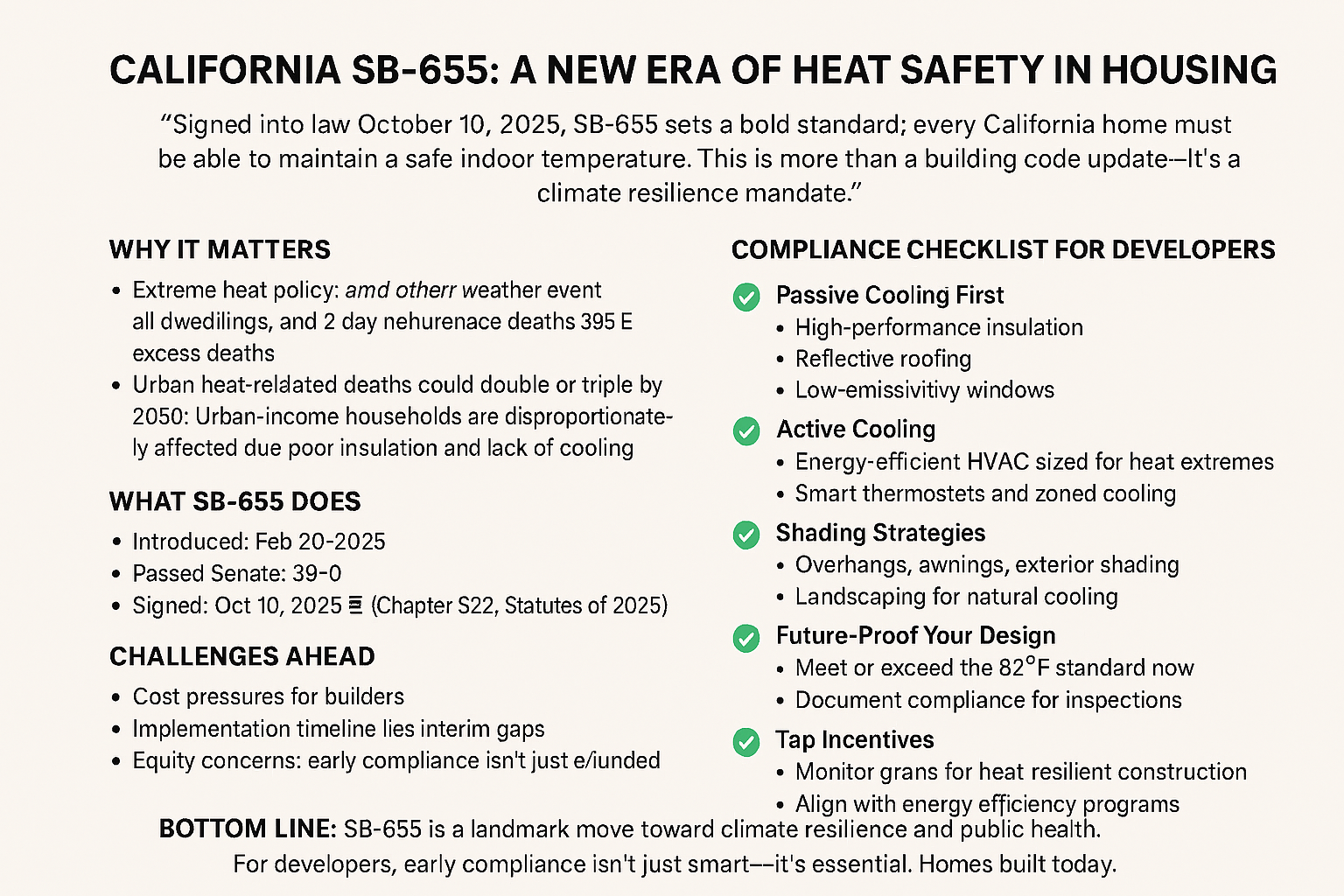Introduction
California Senate Bill 655 (SB-655), authored by Senator Henry Stern, is a crucial response to one of the most urgent climate-related health risks: extreme heat. Signed into Law on 10 October 2025, SB-655 establishes a state policy requiring all residential dwelling units to maintain a safe maximum indoor temperature. This legislation marks a significant shift in housing standards, prioritizing heat safety alongside existing cold-weather protections.
Why SB-655 Matters
Extreme heat is now the leading weather-related cause of death in the U.S., surpassing floods and hurricanes. California’s vulnerability is amplified by:
- Frequent heat waves: A 10-day heat wave in September 2022 caused 395 excess deaths statewide.
- Climate projections indicate that urban heat-related deaths could double or triple by 2050.
- Equity concerns: Lower-income communities often experience higher indoor temperatures due to inadequate insulation and a lack of access to cooling systems.
Key Provisions of SB-655
· State Policy Declaration
o All dwelling units must be able to attain and maintain a safe maximum indoor temperature.
· Agency Responsibilities
o Starting 1 January 2027, agencies such as the Department of Housing and Community Development (HCD), Energy Commission, and Public Utilities Commission must integrate this policy into:
§ Regulations
§ Grant criteria
§ Housing programs
· Building Standards
o The California Building Standards Commission must adopt strategies—both passive and active—such as:
§ Mechanical ventilation
§ Natural ventilation
§ Shading and cooling techniques
o Target: Maximum indoor temperature of 82°F for newly constructed residential units by the next triennial code update after 1 January 2026.
· Limitations
o The bill does not mandate the state to fund cooling infrastructure or create new obligations beyond existing programs.
Legislative Journey
- Introduced: 20 February 2025
- Passed Senate: 4 June 2025 (39–0)
- Passed Assembly: 9 September 2025 (66–5)
- Signed into Law: 10 October 2025 (Chapter 522, Statutes of 2025)
Implications
For Homebuilders
- New construction must incorporate heat mitigation strategies.
- Compliance will influence design, materials, and HVAC systems.
Compliance Checklist for Developers
✅ Passive Cooling First
- High-performance insulation
- Reflective roofing
- Low-emissivity windows
- Cross-ventilation design
✅ Active Cooling
- Energy-efficient HVAC sized for heat extremes
- Smart thermostats and zoned cooling
✅ Shading Strategies
- Overhangs, awnings, exterior shading
- Landscaping for natural cooling
✅ Future-Proof Your Design
- Meet or exceed the 82°F standard now
- Document compliance for inspections
✅ Tap Incentives
- Monitor grants for heat-resilient construction
- Align with energy efficiency programs
For State Agencies
- Must align housing and climate programs with the new policy.
- Potential adjustments in grant funding priorities.
For Residents
- Long-term goal: safer homes during heat waves.
- Particularly critical for mobile homes and older housing stock, which often lack adequate cooling.
Challenges and Criticism
- Cost Concerns: Builders Warn of Increased Construction Costs.
- Implementation Timeline: Agencies have until 2027 to integrate standards, raising questions about interim protections.
- Equity Issues: While the bill sets policy, it does not guarantee financial assistance for retrofitting older homes.
Conclusion
SB-655 is a landmark step toward enhancing climate resilience and protecting public health in California. By codifying a safe indoor temperature standard, the state acknowledges the deadly Impact of extreme heat and begins laying the groundwork for safer housing. This legislation not only addresses a pressing issue but also paves the way for a more resilient and healthier future for all Californians. However, its success will depend on effective implementation, funding strategies, and support for vulnerable communities.
